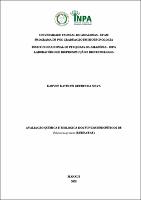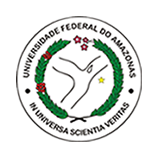| ???jsp.display-item.social.title??? |


|
Please use this identifier to cite or link to this item:
https://tede.ufam.edu.br/handle/tede/11057| ???metadata.dc.type???: | Dissertação |
| Title: | Avaliação química e biológica dos fungos endofíticos de Palicourea prancei (Rubiaceae) |
| Other Titles: | Chemical and biological study of endophytic fungi of Palicourea prancei (Rubiaceae) |
| ???metadata.dc.creator???: | Silva, Karyne Kathlen Guedes da  |
| ???metadata.dc.contributor.advisor1???: | Nunez, Cecilia Veronica |
| ???metadata.dc.contributor.referee1???: | Luiz, Jaine Honorata Hortolan |
| ???metadata.dc.contributor.referee2???: | Pohlit, Adrian Martin |
| ???metadata.dc.description.resumo???: | Os fungos endofíticos isolados de plantas do gênero Palicourea são fontes de moléculas bioativas, com aplicabilidades biotecnológicas. Com o surgimento de novas patologias e a problemática da resistência microbiana aos fármacos convencionais, há a necessidade do desenvolvimento de novos medicamentos. Tendo em vista esse contexto, este estudo averiguou a composição química e as atividades antibacteriana e de toxicidade frente à Artemia salina de fungos endofíticos isolados de folhas de Palicourea prancei, visando a obtenção de substâncias ativas. Os fungos endofíticos de P. prancei foram cultivados em caldo Sabouraud (0,2% de extrato de levedura) em incubadora shaker (30 °C, 120 rpm) durante 20 dias para a obtenção da massa micelial. Os metabólitos dos micélios foram extraídos em solvente metanol (MeOH) e concentrados em evaporador rotatório para aquisição dos extratos brutos. O perfil químico dos extratos brutos foi analisado por cromatografia em camada delgada comparativa (CCDC). Avaliou-se a atividade de inibição bacteriana dos extratos fúngicos pelo método de microdiluição em caldo e o nível de toxicidade frente à A. salina. O fungo selecionado foi cultivado em escala ampliada e seus micélios foram extraídos com MeOH, cujo extrato foi submetido à partição utilizando AcOEt, obtendo-se a fase AcOEt e a fase hidrometanólica. O extrato e as fases obtidas tiveram seu perfil químico analisado por CCDC. Apenas o extrato MeOH e sua fase AcOEt foram analisados por RMN 1H e submetidos aos testes antibacteriano e de toxicidade frente à A. salina. Os maiores valores de massa do extrato MeOH micelial foram apresentados pelos fungos G1 PP8 (738,8 mg), G4 PP11 (456,0 mg) e G6 PP7 (440,2 mg). A partir das análises de CCDC, os extratos brutos dos fungos endofíticos de P. prancei demonstraram indícios de substâncias com ligações duplas, indícios de terpenos, substâncias fenólicas e nitrogenadas. Os extratos MeOH dos fungos G1 PP8 e G2 PP5 testados à 1000 μg/mL apresentaram atividade bacteriostática acima de 35% contra as bactérias Aeromonas hydrophila e Staphylococcus aureus, e o extrato MeOH de G1 PP8 exibiu alta toxicidade contra A. salina, com CL50 = 2,76 μg/mL. O fungo G1 PP8 destacou-se nas análises e foi selecionado para o cultivo em escala ampliada e identificação molecular, sendo identificado como Xylaria cubensis G1 PP8. A fase AcOEt do extrato MeOH dos micélios de X. cubensis G1 PP8 foi fracionada por cromatografia em coluna aberta (CCA), permitindo o isolamento da citocalasina D. O extrato MeOH e sua fase AcOEt não apresentaram atividade antibacteriana, mas mostraram-se tóxicos no ensaio contra A. salina, com CL50 = 84,02 μg/mL (extrato MeOH) e 144,3 μg/mL (fase AcOEt). Os resultados obtidos neste estudo contribuem para o conhecimento químico dos fungos endofíticos de P. prancei, bem como suas aplicabilidades biológicas |
| Abstract: | Endophytic fungi isolated from plants of the genus Palicourea are sources of bioactive molecules with biotechnological applications. With the emergence of new pathologies and the issue of microbial resistance to conventional drugs, there is a need for the development of new medicines. In view of this context, this study analyzed the chemical composition as well as the antibacterial and toxicity activities against Artemia salina of endophytic fungi isolated from Palicourea prancei leaves, aiming at obtaining active substances. The endophytic fungi of P. prancei were cultivated in Sabouraud broth (0.2% yeast extract) in a shaker incubator (30 °C, 120 rpm) for 20 days to obtain the mycelial mass. The metabolites of the mycelia were extracted in methanol (MeOH) solvent and concentrated in a rotary evaporator to obtain the crude extracts. The chemical profile of the crude extracts was analyzed by comparative thin layer chromatography (TLC). The bacterial inhibition activity of the fungal extracts was evaluated by the microdilution method and the toxicity level against A. salina. The selected fungus was cultivated on a large scale and its mycelia were extracted in MeOH, which was partitioned using EtOAc, obtaining the EtOAc phase and the hydromethanolic phase. The extract and the phases obtained had their chemical profile analyzed by comparative TLC. Only the MeOH extract and its EtOAc phase were analyzed by 1H NMR and subjected to antibacterial and toxicity tests against A. salina. Comparative TLC analysis of crude extracts from endophytic fungi of P. prancei indicated the presence of substances with double bonds, terpenes, phenolic compounds, and nitrogenous compounds. The MeOH extracts of the fungi G1 PP8 and G2 PP5 tested at 1000 μg/mL showed bacteriostatic activity above 35% against the bacteria Aeromonas hydrophila and Staphylococcus aureus, and the MeOH extract of G1 PP8 exhibited high toxicity against A. salina, with LC50 = 2.76 μg/mL. The fungus G1 PP8 stood out in the analyses and was selected for large-scale cultivation and molecular identification, being identified as Xylaria cubensis G1 PP8. The EtOAc phase of the MeOH extract of X. cubensis G1 PP8 mycelium was fractionated by open column chromatography (CC), allowing for the isolation of cytochalasin D. The MeOH extract and its EtOAc phase did not show antibacterial activity, but were toxic in the assay against A. salina, with LC50 = 84.02 μg/mL (MeOH extract) and 144.3 μg/mL (EtOAc phase). The results obtained in this study contribute to the chemical knowledge of the endophytic fungi of P. prancei, as well as their biological applicability. |
| ???metadata.dc.subject.cnpq???: | CIENCIAS BIOLOGICAS: BIOQUIMICA: BIOQUIMICA DOS MICROORGANISMOS CIENCIAS EXATAS E DA TERRA: QUIMICA: QUIMICA ORGANICA: QUIMICA DOS PRODUTOS NATURAIS |
| ???metadata.dc.subject.user???: | Bioprospecção Citocalasina Metabólitos secundários Palicourea prancei Xylaria cubensis |
| Language: | por |
| ???metadata.dc.publisher.country???: | Brasil |
| Publisher: | Universidade Federal do Amazonas |
| ???metadata.dc.publisher.initials???: | UFAM - INPA |
| ???metadata.dc.publisher.department???: | Instituto de Ciências Biológicas |
| ???metadata.dc.publisher.program???: | Programa de Pós-Graduação em Biotecnologia |
| Citation: | SILVA, Karyne Kathlen Guedes da. Avaliação química e biológica dos fungos endofíticos de Palicourea prancei (Rubiaceae). 2025. 131 f. Dissertação (Mestrado em Biotecnologia) - Universidade Federal do Amazonas, Manaus (AM), 2025. |
| ???metadata.dc.rights???: | Acesso Aberto |
| ???metadata.dc.rights.uri???: | https://creativecommons.org/licenses/by-nc-nd/4.0/ |
| URI: | https://tede.ufam.edu.br/handle/tede/11057 |
| Issue Date: | 13-Jun-2025 |
| Appears in Collections: | Mestrado em Biotecnologia |
Files in This Item:
| File | Description | Size | Format | |
|---|---|---|---|---|
| DISS_KaryneSilva_PPGBIOTEC | 6.57 MB | Adobe PDF |  Download/Open Preview |
Items in DSpace are protected by copyright, with all rights reserved, unless otherwise indicated.




